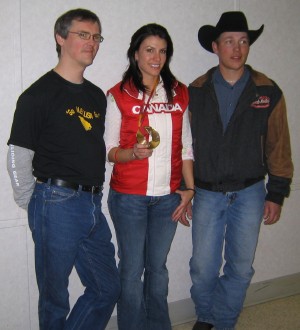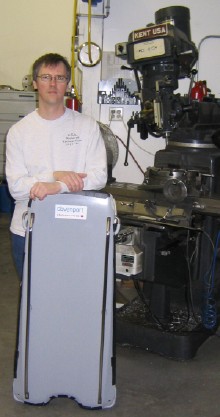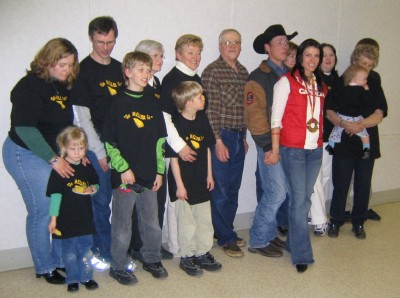A compilation of phrases taken from the Torino Winter Olympics website describes the sport of skeleton as:
“Lying prone, facing downhill, head tucked down, skimming just a few centimeters above the icy track, hurtling down the run at maximum speeds of 130 kilometers an hour, arms at their sides, guided by courage and the most advanced aerodynamic materials.
Skeleton athletes use the same track as bobsleigh and luge. To move the sled, only the thrust force produced by the athlete and the force of gravity are permitted. Steering is carried out by means of the athlete's body movements.”
At competitions, the athletes do two slides of approximately one minute each. The times are added together and the lowest score wins. Wins are a matter of hundredths of seconds ahead of other racers.
The track is a narrow, curved frozen half-pipe, usually about 1400 meters long, down a steep slope. It is very expensive to build and maintain. In Calgary, an entire separate building and several full time staff members are dedicated year-round to producing the right conditions on the competition track.
Why are so few people aware of this sport? Skeleton sliding has had an irregular association with the Olympics, being in the 1928 and 1948 Games as a men only event, starting again as of 2002 as women’s and men’s events. Also, there are only 14 suitable skeleton racing tracks in the world. One of those is located in Sigulda, Latvia, about one hour’s drive from Riga. It was the former Soviet Union’s only bobsleigh track. Of the all the skeleton race tracks worldwide, it is the only one with the first six curves or corners built on pilings, because there is not enough height on the natural hill in that region. An elevator takes the competitors and sleds to the top.

Eckville, Alberta honoured Mellissa Hollingsworth-Richards on March 17th for achieving an Olympic medal and World Cup season over-all win. Ryan Davenport, Mellisa Hollingsworth-Richards with her Olympic bronze medal and her husband Billy Richards. Photo: Helgi Leesment
Two Albertans, cousins Mellisa Hollingsworth-Richards and Ryan Davenport, both of Estonian ancestry have garnered the admiration of their friends and extended families for their achievements in winning Canadian Championships, World Championship and World Cup medals in Skeleton racing. One also earned a Bronze medal in the recent Torino Winter Olympics. The entire Mottus (Mõttus) family in central Alberta is beaming with joy, as many members of that clan have provided extensive support to the two athletes for over a decade.
Mellisa’s rural roots are now into ranching, but they stretch back over 100 years to Rõuge, near Võru in the southeast corner of Estonia.
Mellisa’s and Ryan’s great-grandfather Gustav Mottus left Estonia at the age of 21 in the year 1910, first arriving in New York, then travelling on to homestead at Risula, west of Eckville in Central Alberta by 1911. A small community of Estonians was already settled in the area, and in 1917 he married Linda, the daughter of the first known Estonian to arrive in Canada, Henry (Hendrik) Kingsep and Emilie Saar. Several of Gustav’s siblings also came to settle in Alberta but one brother Jaan remained in Rõuge. Contact was maintained with Jaan until WWII when the Soviet Russian occupation of Estonia forced an end to all written and telephone communication with the outside world. Thus for nearly 60 years neither half of the family knew the other’s fate. Gustav died in 1977. Eventually, the 1999 Centennial Celebration of Estonians in Canada provided the contacts needed for Gustav’s descendants in Canada to find their cousins in Estonia.
Given the speed of emails and easy access to directories via the Internet, it was a mere matter of days until the first email from Jaan’s daughter arrived at the home of Arnold Mottus, grandson of Gustav and uncle to Mellisa and Ryan. Arnold states, “It was without a doubt the most exciting letter I have ever received… an e-mail was sent immediately to Estonia, and many have since been exchanged, along with photo images, as well as letter mail, and a phone call. We are fortunate that the son-in-law in Estonia has access to a computer and can read and write English. His family lives in Võru, close to where Gustav was born.” This story appears on the website http://www3.telus.net/armottus....
No doubt there has been much celebration in Võru as well as in Alberta with everyone following Mellisa’s many successes, especially during the current Skeleton season, the culmination of ten years of serious dedication to the sport her cousin Ryan Davenport convinced her to try. Among Mellisa’s athletic achievements:
• 6 times medallist in Canadian championships, including a Gold in 1996
• Year 2000 silver medallist at the World Championship with 10th to
5th placements 2003-2005
• World Cup top standing for the 2005-2006 season after placing 3rd in two races, second in 3 races and first in 2 races, medalling at all of the seven international competitions held in Latvia, Germany, Switzerland, Austria, USA and Canada.
• Bronze medal at the 2006 Winter Olympics at Torino
Part of Mellisa’s success is due to the custom-made sled she uses, designed and manufactured by her cousin Ryan Davenport. Ryan first noticed this high-speed sport in a newspaper article in Calgary in 1992 and immediately signed up at the first Canadian Skeleton School for training. Calgary is fortunate in having the legacy of several winter sport facilities, including a world-class skeleton/luge/bobsled racetrack, thanks to hosting the 1988 Winter Olympic Games. The Canadian Skeleton championships have been held exclusively at Calgary’s Canada Olympic Park each year as of 1987. This facility also hosts World Cup or World Championship skeleton competitions almost each year. Starting in the 1992-93 competitive season, Ryan was the undisputed long term Canadian Champion, winning 7 Gold medals until he retired as an athlete at the end of the 1998-99 season. He also won 2 World Championship Gold medals (1996 & 1997) and a bronze in 1995. Unfortunately, skeleton was not an Olympic sport during this time.
Despite his retirement, Ryan is still intimately involved with Skeleton sliding. After severely damaging his sled at a 1994 competition, he tried to fix it. That led to him making a new sled for himself. His teammates were so impressed with the result, they requested him to also custom-make sleds for them. By 1995 he had established Davenport Sleds www.davenportsleds.ca as his full time business.

Ryan Davenport, seven-time Canadian skeleton champion and manufacturer of skeleton sleds with one of his custom-made creations, manufactured at his factory near Calgary. Photo by Peeter Leesment
Skeleton sleds are precision designed. The governing sport body, the International Bobsleigh and Tobogganing Federation (FIBT) has detailed stringent requirements and restrictions as to size, composition of materials, bolting, welding, weight, etc. etc. The Davenport firm custom designs skeleton sleds within all those specifications, further taking into consideration each racer’s height and various permitted preferences. The finished product typically costs approximately $4000. A long way from the creaky wooden sleds we used as kids.
In addition to dedicating much time, effort and money into athletic training, Mellisa spends time on the Rodeo circuit, having grown up on her father’s horse ranch in central Alberta. She married saddle bronc rodeo cowboy Billy Richards last June and now lives on a ranch west of Calgary where the Richards family raises horses for the Calgary Stampede and other rodeos. Her husband plus 12 other members of her family and her sponsor were at Torino, Italy in support. The main sponsor, True Energy Trust, gifted the couple a weeklong delayed honeymoon in Mexico immediately after the Olympic Games.
Mellisa has her sights set on Vancouver/Whistler 2010 and will continue training and racing. Her progress can be tracked on her website
www.go-Mellisa-go.ca.
The Town of Eckville and Mellisa’s extensive family held an appreciation night in her honour at the local Community Centre on March 17, attended by approximately 250 fans. Helen Posti, the mayor of Eckville (population 1200), was among the many who lauded the local Olympic athlete, especially for her constantly positive attitude. Mellisa’s emotional account of her training and the Olympic race had many listeners in tears by the time of their standing ovation. Everyone had an opportunity to be photographed with Mellisa, get her autograph and to momentarily hold an actual Olympic medal. Mellisa, in turn, graciously dedicated her time that evening to all the Eckville supporters who have been with her for the ten long years leading up to her Olympic medal.

Part of Mellisa's extended family that were present at the special evening in Eckville honouring her World Cup season victory and Olympic bronze medal. Mellisa is wearing her Olympic bronze medal. On Mellisa's left is her husband Billy Richards, next to him is Mellisa's uncle Arnold Mottus, keeper of the Mottus clan family history and family tree. The young man with glasses at the left side is Ryan Davenport, Mellisa's cousin and seven-time Canadian skeleton champion and manufacturer of skeleton sleds. Photo: Peeter Leesment


















